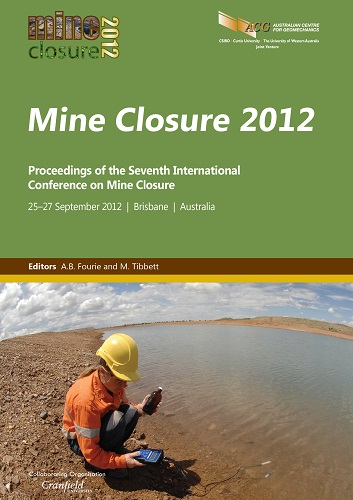Sustainable mining now: turning ideas and ideals into reality

|
Authors: Abbott, RM; McKenna, GT |
DOI https://doi.org/10.36487/ACG_rep/1208_64_McKenna
Cite As:
Abbott, RM & McKenna, GT 2012, 'Sustainable mining now: turning ideas and ideals into reality', in AB Fourie & M Tibbett (eds), Mine Closure 2012: Proceedings of the Seventh International Conference on Mine Closure, Australian Centre for Geomechanics, Perth, pp. 771-781, https://doi.org/10.36487/ACG_rep/1208_64_McKenna
Abstract:
Most mining companies are committed to sustainability. Many are on a path towards corporate change that is plotted over decades and held largely separate from mine operations and corporate or line decision-making. Efforts and publications to date they have not confronted the urgency of the sustainability challenge and have failed to provide clear, tangible advice on ‘how to turn ideas and ideals into reality.’ This paper redefines sustainable mining as the emergent outcome of seven elements: engaging communities and earning trust; exercising planning, decision making, and design with flair; executing promises operationally; empowering employees; efficiently managing resources; exceeding shareholder expectations; and enhancing the environment. ‘Sustainable mining now’ offers a three year blueprint for corporate executives and mine managers to implement meaningful sustainable mining such that it becomes the new normal just as safety and environmental protection have become the new normal at most mines. Mining sustainably starts during exploration, continues through operation, and many of the results are most evident during reclamation and mine closure after mining ceases and the land is readied for new uses. Building reclaimed watersheds and landscapes collaboratively with the new users is central to this new way of doing business, achieving ‘successful reclamation’ together. Examples of mines achieving one or more of the seven elements, and tools for collaboration and landform design are becoming available to aid interested mines, their shareholders, and stakeholders. Sustainable mining as we define it is not ‘nice to have’; it is smart business.
References:
Cronon, W. (1995) Uncommon ground: toward reinventing nature, W.W. Norton & Co., New York, 561 p.
McHarg, I, (1969) Design with Nature: New York, Wiley, 197 p.
McKenna, G.T. (2002) Sustainable mine reclamation and landscape engineering, PhD Thesis, University of Alberta, Edmonton, Canada, 661 p.
SAPSM (2010) Strategic Advisory Panel on Selenium Management. The Way Forward: A Strategic Plan for the Management of Selenium at Teck Coal Operations, viewed 3 August 2012, Site/Responsibility Pages/Sustainability Pages/Environment Pages/.
© Copyright 2025, Australian Centre for Geomechanics (ACG), The University of Western Australia. All rights reserved.
View copyright/legal information
Please direct any queries or error reports to repository-acg@uwa.edu.au
View copyright/legal information
Please direct any queries or error reports to repository-acg@uwa.edu.au